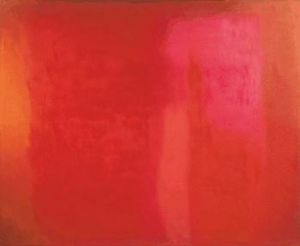Esteban Vicente facts for kids
Quick facts for kids
Esteban Vicente
|
|
|---|---|

Red Field, 1972, oil on canvas, 56 1/8 x 68 1/8 inches, Museo de Arte Contemporáneo Esteban Vicente
|
|
| Born |
Esteban Vicente Pérez
January 20, 1903 Turégano, Spain
|
| Died | January 10, 2001 (aged 97) |
| Nationality | Spanish, American (since 1940) |
| Education | Royal Academy of Fine Arts of San Fernando, Madrid |
| Known for | Painting, Sculpture, Printmaking, Drawing, Collage |
| Movement | Abstract expressionism |
Esteban Vicente Pérez (born January 20, 1903 – died January 10, 2001) was a famous Spanish-American painter. He was born in Turégano, Spain. He became one of the first artists in a group called the New York School, known for a style called abstract expressionism. He was also strongly against fascism, a type of strict political rule.
Contents
Esteban Vicente's Early Life
Esteban Vicente was born in Turégano, Spain, on January 20, 1903. His mother, Sofia Pérez y Álvarez, was from an Asturian family. His father, Toribio Vicente Ruiz, was an army officer. Esteban was the third of six children.
When Esteban was young, his family moved to Madrid, the capital of Spain. His father, who loved art, took him to the Museo del Prado almost every Sunday. This was a famous art museum. Esteban started drawing when he was sixteen years old. Even though his family expected him to join the army, he decided to become an artist instead.
Art Training and Education
In 1921, Vicente enrolled at the Real Academia de Bellas Artes in Madrid. This was a well-known art school. He planned to study sculpture there. He finished his training in 1924. He later said that the Academy taught him useful tools and how to work with different materials, but it didn't give him new ideas.
Esteban Vicente's Art Career
Esteban Vicente had his first art show in Madrid in 1928. After that, he moved to Paris, France, and then returned to Spain in 1930. In 1935, he married Estelle Charney, an American woman he met in Paris.
Moving to New York City
In 1936, the Spanish Civil War began in Spain. Vicente supported the Loyalist side, which was against the strict government. For a few months, he helped by painting camouflage in the mountains near Madrid. Later that year, he and his wife moved to New York City in the United States.
He worked as a Vice Consul in Philadelphia for three years, which helped support his family. This job also gave him plenty of time to continue his art. He had his first solo art show in New York in 1937. After the Spanish Republic fell in 1939, he returned to New York City. During World War II, he earned money by painting portraits and teaching Spanish.
Becoming a New York School Artist
In 1946, he taught painting at the University of Puerto Rico. After returning to New York in 1947, he became friends with many artists who were part of the new New York School. This group was known for abstract art. He showed his work in important exhibitions, including the 9th Street Art Exhibition in 1951. Later, his art was shown in famous galleries like the Leo Castelli Gallery.
Vicente was also a founding member of the New York Studio School, where he taught art for 36 years. Even though he never had art shows in Spain while Francisco Franco was in power, the Spanish government opened the Esteban Vicente Museum of Contemporary Art in Segovia in 1998.
Later Life and Legacy
From 1964, Vicente had a house and art studio in Bridgehampton, New York. He passed away in Bridgehampton on January 10, 2001. He was survived by his third wife, Harriet Peters.
Esteban Vicente is honored in many ways. A public school in the Bronx, New York City, called PS 170, is named the Esteban Vicente school. Art programs have been started there, and students learn about his style and use of color. Examples of his artwork are displayed on the school's walls.
There is a museum dedicated to him in Segovia, Spain, called the Museo de Arte Contemporáneo Esteban Vicente. A street in his hometown of Turégano is also named after him.
In March 2011, the Grey Art Gallery at New York University held an exhibition called Concrete Improvisations: Collages and Sculpture by Esteban Vicente. This show featured 60 paper collages and 20 of his small sculptures. These sculptures, which he called divertimentos (toys), were made from pieces of found wood and covered with white plaster, or from plastic and wood with architectural shapes.
See also
 In Spanish: Esteban Vicente para niños
In Spanish: Esteban Vicente para niños

